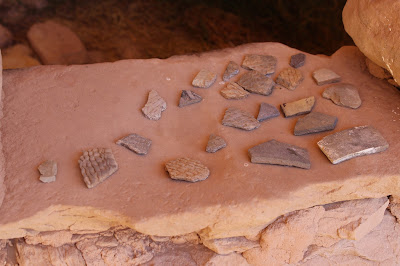
Round Trip Distance: 2 miles
Difficulty: Moderate
Elevation: 4657 - 4842 feet
Cellphone: 0-3 bars
Time: 1 hr. 45 mins.
Trailhead: Cold Springs
Fee: $5/person/day
Attractions: Cliff dwellings, rock art, pottery sherds
The Cold Spring Cave trail is located on the east side of Comb Ridge in the Butler Wash area near Bluff, Utah. The trail crosses Butler Wash where it follows a narrow canyon that penetrates Comb Ridge leading to a series of cliff dwellings that are situated beneath an overhang and within a cave at the head of the canyon. Comb Ridge stretches for about 30 miles in a north-south direction. The uplifted monocline drops precipitously in most places on its western side whereas the eastern flank, which has a more gentle slope, is grooved with canyon after canyon giving it the appearance of a comb. The ridge presented itself as a great frustrating barrier to early pioneers that were seeking wagon routes through the area.
The unmarked trailhead for the Cold Spring Cave trail is located about 2 tenths of a mile north of the Monarch Cave trailhead. We have created our own map of the area that you might like to print and take along that shows the distances from Highway 163 to each of the most popular trailheads.
From the parking area the trail crosses a shallow wash and continues along an old jeep road. The road passes right over an archaeological site a short distance from the trailhead where there was possibly a pueblo and/or kiva at one time. Watch for a well worn trail that leaves the road about a quarter mile from the parking area and heads toward the wash.
After crossing the main Butler Wash stay above the side wash as you head toward the mouth of the canyon. The wash is choked with brush in places making it more difficult to hike. There are trails that split off of the main route that look like they might lead to something interesting if you have extra time.
As you hike up the canyon you will come to a fork. The trail to Cold Spring Cave heads up the side canyon on the right. The turnoff into the side canyon is about 8 tenths of a mile from the trailhead. From here the trail climbs up the left side of a small spillover and enters the almost hidden canyon.
Ruins line the wall on the right from the bottom of the overhang all the way up to the cave near the head of the canyon.
An inscription on a rock within the cave that was made in 1892 gives name to the site.
Most every rock of any size that you can see, as well as some areas of the cliff, have petroglyphs on them. Other rocks appear to have served as metates while some have holes and channels that may have been used to capture rainwater that was dripping down the overhang.
A considerable number of hand pictographs adorn the lower walls of the cliff.
It looks like several varieties of corn may have been grown here. The longest cobs were only about 4 inches in length.
And there is also the remains of a kiva.
The remains of what looks like a small well built storage room is very interesting. Look at the rocks that form the sides of the opening.
Previous visitors have been kind enough to leave the fragments of pottery for others to enjoy.
Butler Wash is fun to visit. Because of the shortness of most of the hikes you get a chance to see multiple sites in one day. At present primitive camping is permitted pretty much anywhere you can pitch your tent. We have also seen people pull small trailers into the area. The towns of Bluff and Blanding are near each end of the Butler Wash Road for those that aren't interested in 'roughing it'. The Cold Spring Cave, like all the other sites in the area, needs all of the TLC that it can get to help protect its deteriorating walls and rock art. If you would like to see it for yourself then all you have to do is 'Take a hike'.















